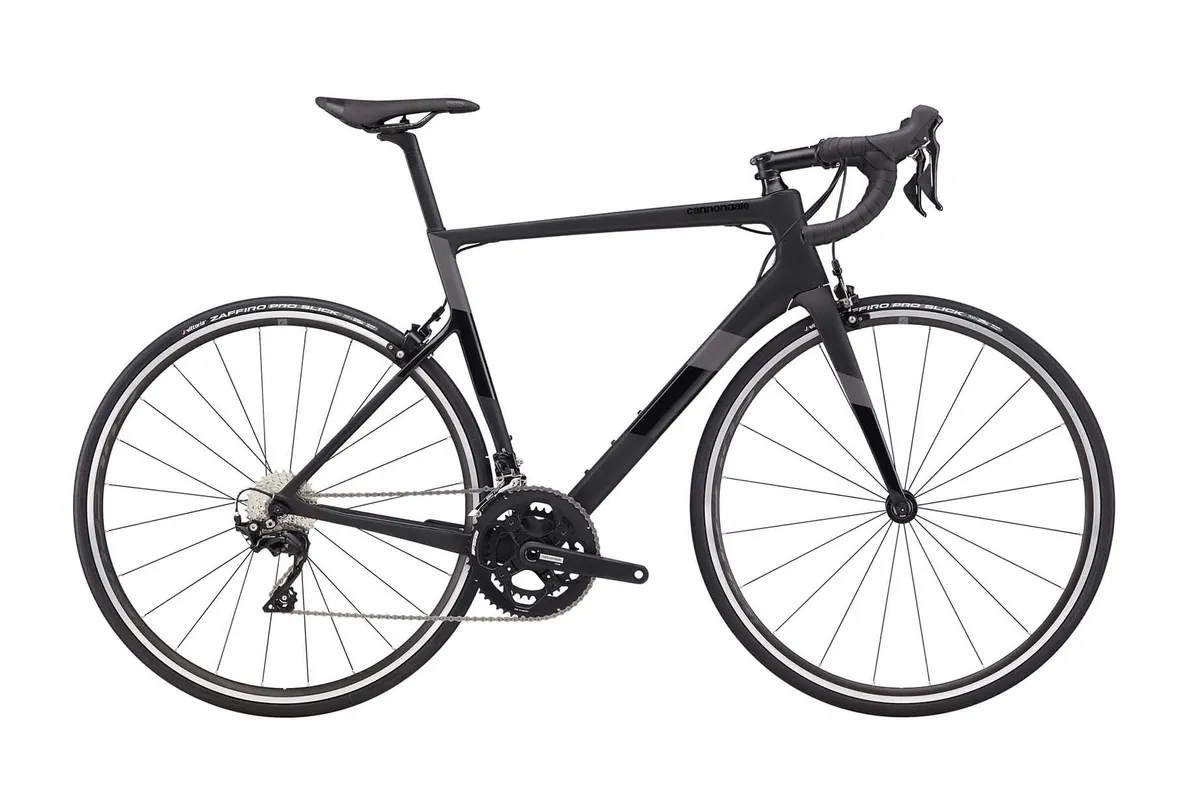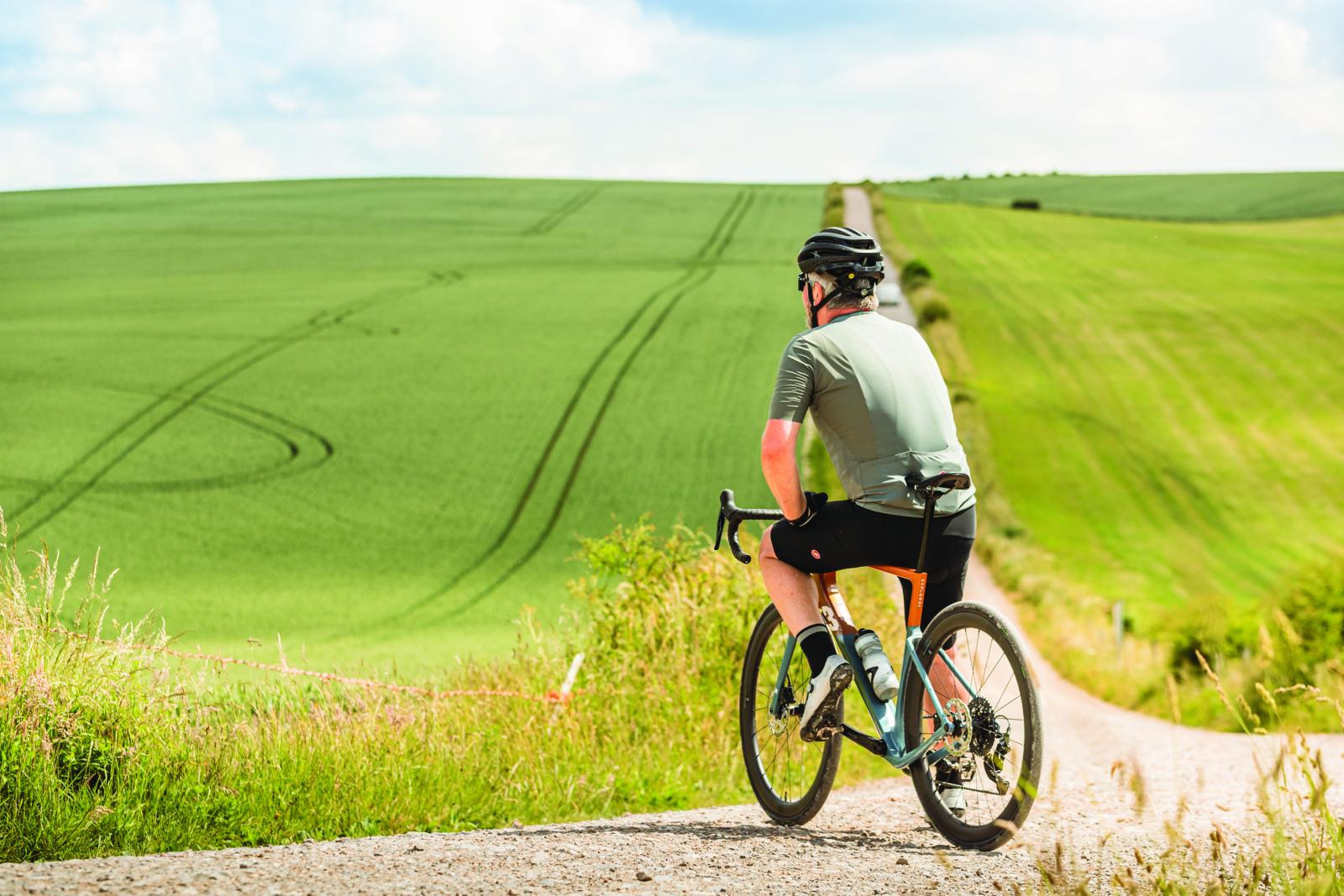Cannondale’s SuperSix began life back in 2008 (as ridden by Team Liquigas-Cannondale) and in 2011 came the original EVO. It was significantly lighter than the 2008 bike and was the first to explore comfort as a performance benefit.
- Cannondale EVO SuperSix Hi-Mod Dura-Ace first ride review
- Cannondale SystemSix Hi-Mod Dura-Ace Di1 review
The second-generation EVO in 2015 was lighter still and also had a much-improved ride quality. Later a disc version arrived.
The SuperSix EVO (2) was a true milestone bike. It was a bike that defined the era of lightweight carbon; phenomenally light in its day and still a flyweight proposition today.
It wasn’t just lightness that defined the EVO though — it was a perfect balance of lightness and handling with a ride that wouldn’t beat you up. That it did this with a traditional frame shape and mostly round tubes added an air of classic style.
Even now, the EVO 2 (as it will be known here) is my personal handling benchmark on how all other race bikes are judged, and let’s not forget that the EVO was still winning races this spring in races such as the Tour of Flanders no less.
Cannondale, it seems, felt much the same way about the EVO. It’s stayed in the range despite all of its rivals adopting aerodynamics and new ideas on frame shaping, and while the sublime ride may not have dated, some others areas may well have.
A four-year design project

The new EVO — or EVO 3 as we’ll refer to it — was a four-year undertaking. The engineering team involved worked under the guidance of product director David Devine and doctor of engineering and mastermind behind the SystemSix, Dr Nathan Barry.
David Devine explains: “We absolutely knew that we needed to retain the sense of the EVO, and the lightness, the handling, and the ride. The EVO is evolving its key values of lightweight, and for the first time on EVO, real aerodynamics, where lower drag does deliver discernible benefits.”
Dr Nathan Barry adds: “David’s brief for the project was ‘Save drag but don’t increase weight is the goal for the new EVO’. It’s reminiscent of the goals for the second-generation EVO where it was all about ‘Lose weight, add comfort, but maintain the EVO feeling and handling that we love’.”
This just goes to show how the priorities of a lightweight race bike, as opposed to the full aero approach of bikes such as the SystemSix, Venge, Foil, and Madone, have changed in the intervening years.
Barry adds that: “Aero efficiency has a huge effect on speed in cycling, so drag reduction was a priority, but the added complications were to retain lightweight, and the responsive handling with the composed ride that made the previous bike so successful.”
The EVO goes aero
The EVO 3 does look radically different from the outgoing bike, and in the same measure, it looks very similar to rivals from the likes of Specialized (Tarmac), BMC (Roadmachine), and Focus’ Izalco Max disc.
But while Barry did explain how aerodynamic solutions are indeed similar across a range of bikes (just as they are similar in Formula 1 or a myriad of sports based around speed), it’s the details in the EVO’s design that give it the edge.
The secret of the new design is a library of tube shapes that the team developed around the EVO design. The SystemSix had deep aerofoil shapes in its build-up and many of them using the Kammtail principles to stay within rule constraints.

A Kammtail tube shape is a truncated airfoil that ‘cheats’ the air into believing that the tail is still there so it acts in a controlled manner and doesn’t create a disruptive ‘wake’ — think of a cross-section of an aircraft wing with the tail of the teardrop shape cut-off. This is known as separated (air) flow and means relative drag in the opposite direction of the structure’s movement.
With the EVO, the tube shapes created are an evolution of these shapes; more blunted in nature and much smaller in size to retain the low-weight aspect at the heart of the EVO ethos.
Barry tells us that “We developed a family of new low-aspect ratio tube shapes, these are proven to reduce drag by over 30 percent [at the wind tunnel tested speed of 30mph] compared to the round tubes of the EVO 2, and if you take into account that at 15kph, 50 percent of your power is overcoming air resistance, the savings can make a big difference to every rider.”
A wind tunnel proven design
Once the design was tested and proven from a structural perspective, Cannondale’s engineering team camped out at the low-speed San Diego wind tunnel to compare the new EVO against its main rivals. These being the Specialized S-Works Tarmac Disc, Cervélo's R5 Disc, Trek's Émonda SLR Disc and BMC's Roadmachine SLR 01.
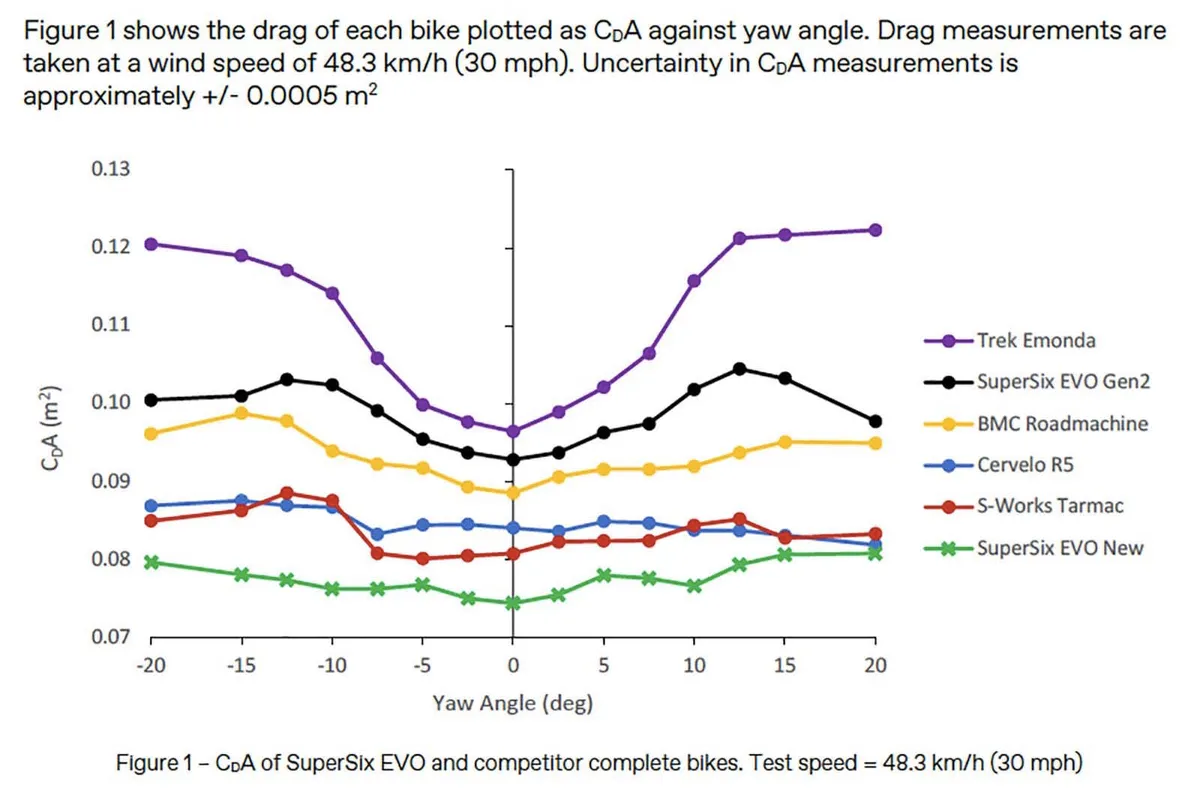
The test showed that the EVO had a significantly lower drag number than all of its rivals across a wide range of yaw angles.

This second graph shows these figures put into context using the Yaw weighted drag calculation developed by Barry as part of his PHD in aerodynamics; a method which combines aerodynamic performance across the yaw spectrum with the probability of riding at any given yaw angle.
This process brings together the huge complexities of every measure at angles and a wide range of speeds into a single unit of drag. It’s kind of like averaging out the aero-performance of a full ride for a combined on-road aerodynamic performance.
Within these numbers you can see its nearest rival — the S-Works Tarmac — carries the equivalent of 9 watts more drag.
Competitor specifications
Specialized S-Works Tarmac
- Handlebar: S-Works Shallow Bend
- Stem: S-Works SL
- Wheels: Roval CLX 50
- Tyres: S-Works Turbo Cotton 26C
Cervélo R5
- Handlebar: Cervélo
- Stem: Cervélo AB06
- Wheels: DT Swiss PRC 1400 Spline 35
- Tyres: Conti GP4000S II 25C
BMC Roadmachine
- Handlebar: BMC Ergo bar
- Stem: BMC ICS
- Wheels: Enve AR 4.5
- Tyres: Vittoria Corsa Control 28C
Trek Émonda SLR
- Handlebar: Bontrager XXX bar-stem
- Stem: Bontrager XXX bar-stem
- Wheels: Bontrager Aeolus XXX 2
- Tyres: Bontrager R4 25C
For more details and testing data on the SuperSix EVO, see Cannondale’s Take Flight Technical Paper at Cannondale.com/SuperSixEVO
Beyond the wind tunnel
The EVO’s aero success is down to a combination of tube shaping and a lot of integration work that’s gone into the core of the bike.
Up front, the EVO features a new aerodynamic stem and bar system that was developed from the SystemSix’s unique KNOT design. This new KNOT bar and stem combo uses the same stem that eschews a traditional clamp in favour of a cradle that the bar sits on (the bolts thread through the bar) and offers 8 degrees of pitch adjustment.
The stem comes in 80 to 120mm lengths, and Cannondale dealers should have a stock of different lengths to ensure the correct fit.
The bar, however, is much slimmer than the SystemSix’s aero design, but is still designed to be aero, combined with lightness and comfort, as per the ethos of the EVO. This new bar/stem combo has a claimed 9.1w saving over the standard round-tubed cockpit found on the previous EVO.

At the back a D-shaped post has been adopted, like pretty much every one of Cannondale’s rivals. The Cannondale design is slightly different though because it’s based on the dimensions of its slimline 25.4 round tube standard. This super-thin seatpost uses the brand’s SAVE carbon technology, which it claims is significantly more comfortable than the previous round post — and it's also more aero, of course.
This fits into the frame using a new hidden seat binder, which is similar to that found on the Synapse, but with a simpler single-piece wedge. This binder weighs just 13g and in combination with the new ultra-thin post, saves 35g over the previous bike’s design.
The dropped seatstays run into SAVE carbon chainstays at the back and this is the biggest departure from the old model. We can see this is where the new EVO will receive the most criticism — dropped stays are fashionable (see BMC, Focus, Specialized, Ribble, Canyon, et al) and the traditional shape of the outgoing model was one thing that made it stand out.
However, Devine explained that the dropped stay design does have the proven advantages of improved comfort and increased aerodynamics, and if you’re looking to exploit every advantage available to you, then sentimental reasons for looking different, or staying classic, are hard to justify.
When it comes to weight, it seems the new EVO hits the right notes though, with quoted, claimed figures of 866g for a 56cm frame (fully painted with all fittings in place), combined with a 389g fork and the dedicated seatpost hitting 162.4g on the Hi-Mod frameset.
The Ballistec carbon chassis weighs in at a claimed 999g for the frame and 436g for the fork and it uses the same 162.4g SAVE carbon seatpost. That makes the new frame Cannondale’s lightest disc frameset to date.
For the Ballistec carbon rim brake model, the frame weight is a claimed 976g and the fork 368g, and it shares the same seatpost.
New wheels

It’s not just in the chassis where Cannondale looked to make an advantage, it was in the wheels too.
Following on from the deep, wide KNOT 64s found on the SystemSix, Cannondale has developed a new aero all-round wheel called the KNOT 45.
This new profile wheel is 45mm deep and 32mm wide externally, so like the 64s on the SystemSix you can see the carbon rim sitting wider than the tyre.
The new wheels were tested against most of their rivals and the wheelset that came closest to the drag number achieved by the 45s was Zipp’s 303 NSW, where the 45s showed a 3 watt saving.
Keeping the HG45 wheels in place is a pair of Speed Release axles, which we first saw on Cannondale’s SystemSix.
The Speed Release uses a 12mm axle that threads into the dropout just like a standard thru-axle, but the lever side features a slotted dropout. When you undo the 12mm thru-axle in the normal way, the double-lead thread on the axle means it’ll tighten and vice versa in five turns rather than the usual 10.
The thru-axle then slides out part way, but is anchored via a slot in the hub and a rubber ring on the axle, so it never needs to be fully removed, making refitting or switching a wheel both a quick and clean option because you don’t have to leave your greased-up thru-axle on the roadside while fixing a puncture.
New geometry

The EVO retains the same ‘performance’ ride position as the previous bike, sitting between the long and low position of the SystemSix and the shorter and taller geo of the Synapse, but it’s changed a little over the previous EVO.
My test bike had a 594mm stack compared to 584mm on the previous model, and a reach of 395mm compared to 399mm on the older bike. The wheelbase has grown by 5mm, up to 1,005mm, to take into account much more generous tyre clearances — up to 30c tyres with 6mm of clearance all round using Cannondale’s own (very) wide carbon rims.
The fork offset, trail and head angle are all basically the same, which should instil the EVO 3 with the same handling character as the previous model.
Power options

An interesting development for the Hi-Mod carbon models is the inclusion of a power meter. We’ve seen Specialized includes its own power meter, developed in conjunction with 4iii, on S-Works level bikes but that does add a premium to those models.
Cannondale’s take on it is a first for bike sales, by including a Power2Max meter built onto its own SiSL2 cranks, but the meter isn’t actually activated. To activate you pay a single payment through Power2Max of £430 / €490 / $490.
Cannondale introduced this with the launch of last year’s SystemSix Hi-Mod, and it means if you’re interested in power, the bike has it, and if not, it could potentially be a good bargaining chip to haggling down the price.
If you were to buy the equivalent aftermarket meter from Power2Max you’d be looking at over €600 plus the cost of fitting and not forgetting a set of compatible chainrings.
Digital and connected bikes
The SuperSix EVO 3 also features the wheel sensor that debuted just a few months ago on Cannondale’s urban Treadwell bikes, and then on the new Topstone Carbon. This wheel sensor was developed in partnership with Garmin and works in conjunction with Cannondale’s own app.
The sensor measures speed, time and distance, and has on-board storage for up to 900 hours — it works with the app or any head unit (BLE and ANT+ compatible). It automatically records all rides and runs off a CR2032 cell (with a year’s claimed battery life) and will also be available aftermarket.
Working with the app it instantly logs rides, saves 30 days of riding and can be used during a ride to display distance, speed and calories. It will also tell you how much fuel you’ve saved (as opposed to using a car) and C02 emission reduction.
Connect it to your bike simply by spinning the wheel and then register the bike for its warranty. It also gives bike ‘health’ reminders, and you can add fit and setting details particular to your own bike.
The app also features achievements and goals, service schedules, technical manuals, links to video how-tos, and an X-ray function that uses augmented reality to show what’s going on underneath the skin of the bike, such as internal cable routing. The app can be used as a standalone ride log or in conjunction with Strava or whatever platform you use.
Cannondale SuperSix EVO range
The SuperSix EVO 3 has a huge range at launch, with bikes available in Ballistec carbon and premium Hi-Mod optimised carbon. Plus, on the two rim brake models there’s a carbon level that sits between Ballistec and Hi-Mod.
Yes, you read that correctly, Cannondale has launched the new EVO with a rim brake option. The rim brake-equipped models use the direct-mount brake standard and come low down in the overall pecking order, so we reckon this is probably only a transition model for the traditionalists out there and will in due time be quietly dropped from the range.
Even so, with 12 models in the range and four women’s models, Cannondale appears to be going all-in with the latest EVO.
SuperSix EVO Hi-Mod Disc Dura-Ace Di2

- $11,500 / £8,999.99
Shimano Dura-Ace Di2 (52/36, 11-30), Hollowgram KNOT 45 SL wheels, Hollowgram SiSL2 chainset with Power2Max NG ECO power meter, Hollowgram Systembar SAVE carbon bar, Hollowgram KNOT alloy stem, ProLogo Dimension NDR Nack saddle, Cannondale wheel sensor.
SuperSix EVO Hi-Mod Disc Ultegra Di2

- $7,750 / £6,499.99
Shimano Ultegra Di2 (52/36, 11-30), Hollowgram KNOT 45 SL wheels, Hollowgram SiSL2 chainset with Power2Max NG ECO power meter, Hollowgram Systembar SAVE carbon bar, Hollowgram KNOT alloy stem, ProLogo Dimension NDR saddle, Cannondale wheel sensor.
SuperSix EVO Disc Ultegra Di2 Women’s
- $6,700 / £5,499.99
Shimano Ultegra Di2 (52/36, 11-30), Hollowgram KNOT 45 SL wheels, Hollowgram SiSL2 chainset with Power2Max NG ECO power meter, Hollowgram Systembar SAVE carbon bar, Hollowgram KNOT alloy stem, ProLogo Dimension space saddle, Cannondale wheel sensor.
SuperSix EVO Disc Force AXS eTap

- $6,500 / £4,799.99
SRAM Force eTap AXS, Hollowgram 35 wheels, Hollowgram Systembar SAVE carbon bar, Hollowgram KNOT alloy stem, ProLogo Dimension NDR saddle, Cannondale wheel sensor.
SuperSix EVO Disc Ultegra
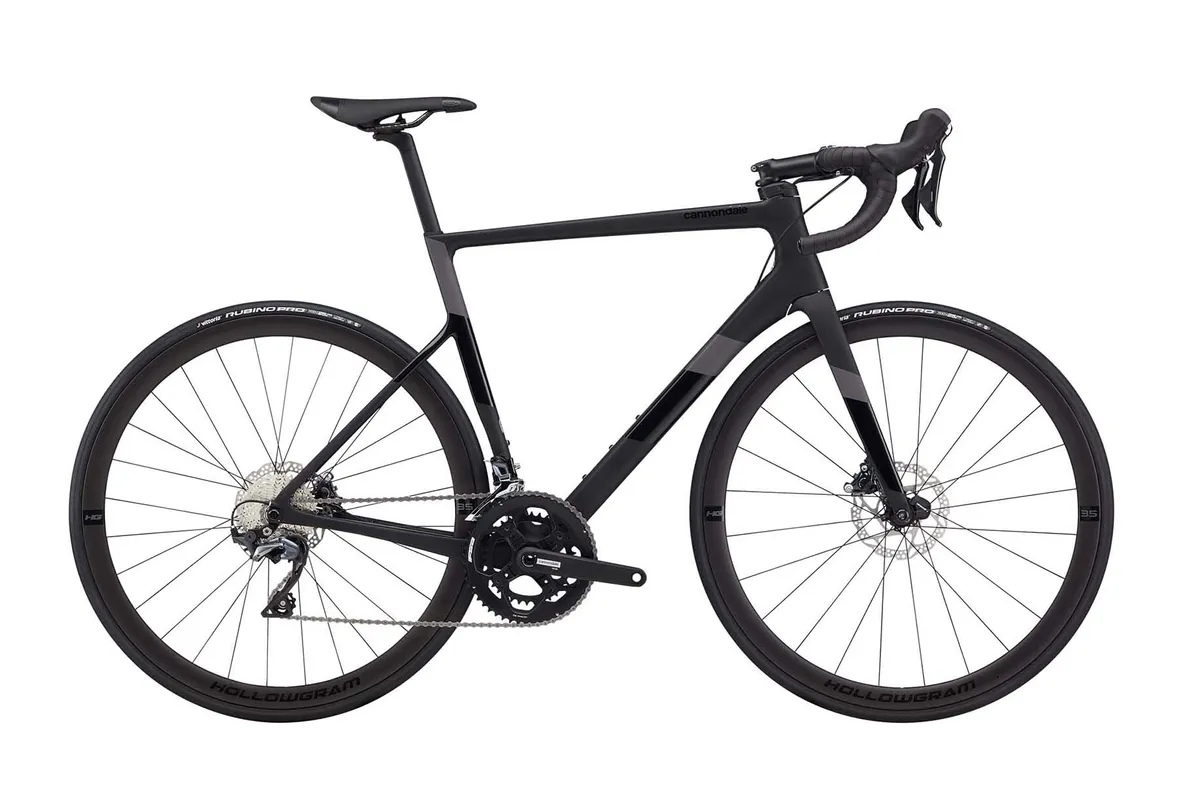
- $4,000 / £2,999.99
Shimano Ultegra (52/36, 11-32), Hollowgram 35 wheels, Hollowgram Systembar SAVE carbon bar, Hollowgram KNOT alloy stem, ProLogo Dimension NDR saddle, Cannondale wheel sensor.
SuperSix EVO Disc Ultegra Women’s

- $4,000 / £2,999.99
Shimano Ultegra (52/36, 11-32), Hollowgram 35 wheels, Hollowgram Systembar SAVE carbon bar, Hollowgram KNOT alloy stem, ProLogo Kappa Dea RS saddle, Cannondale wheel sensor.
SuperSix EVO Disc 105

- $2,750 / £2,299.99
Shimano 105 (52/36, 11-32), Fulcrum Racing 900db wheels, Cannondale 3 bar, Cannondale 3 stem, ProLogo Nago RS saddle.
SuperSix EVO Disc 105 Women’s

- $2,750 / £2,299.99
Shimano 105 (52/36, 11-32) Fulcrum Racing 900db wheels, Cannondale 3 bar, Cannondale 3 stem, ProLogo Dea RS saddle.
SuperSix Evo Ultegra 2

- £2,499.99 / $TBC
Shimano Ultegra (52/36, 11-32) Fulcrum Racing 500 wheels, Cannondale 3 bar, Cannondale 3 stem, ProLogo Nago RS saddle.
SuperSix EVO 105 Women’s
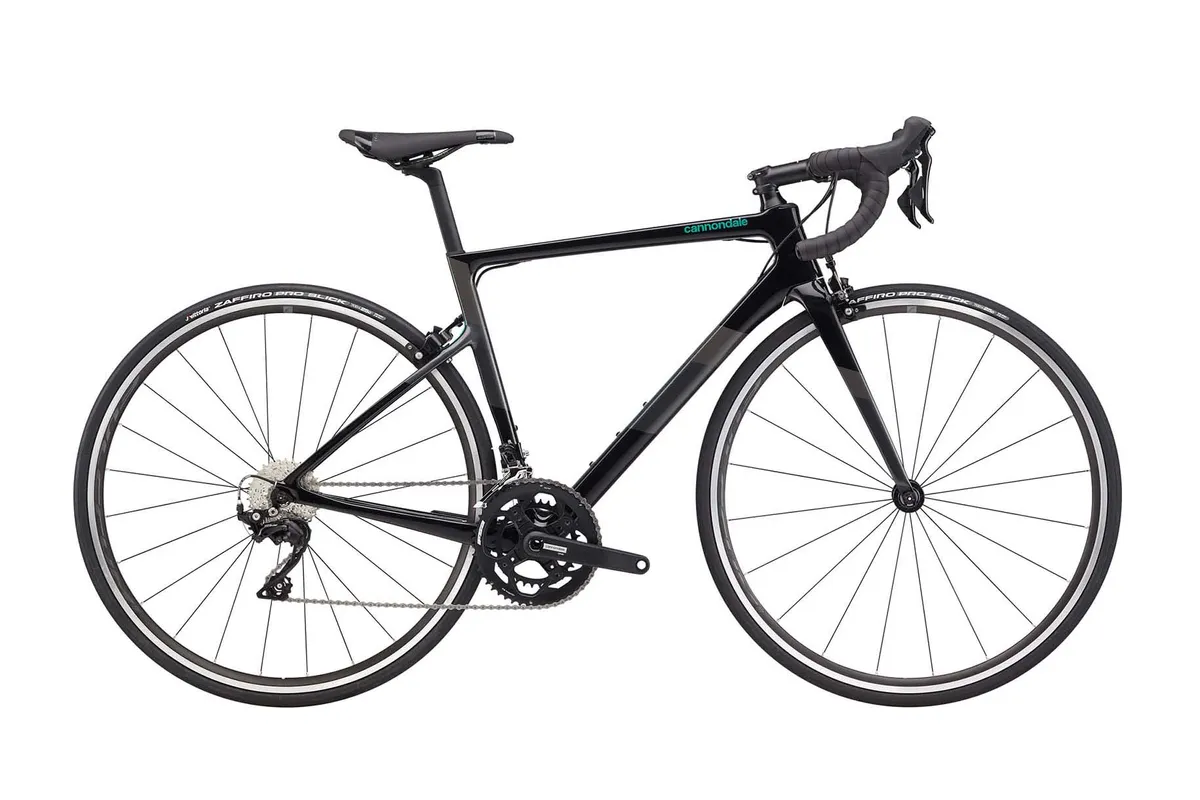
- £1,999.99 / $2,200
Shimano Ultegra (52/36, 11-32), Fulcrum Racing 900 wheels, Cannondale 3 bar, Cannondale 3 stem, ProLogo Kappa Dea RS saddle.
SuperSix EVO 105

- £1,999.99 / $2,200
Shimano Ultegra (52/36, 11-32), Fulcrum Racing 900 wheels, Cannondale 3 bar, Cannondale 3 stem, ProLogo Nago RS saddle.
